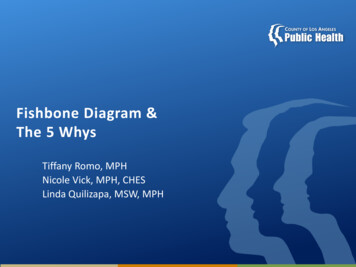
Transcription
Fishbone Diagram &The 5 WhysTiffany Romo, MPHNicole Vick, MPH, CHESLinda Quilizapa, MSW, MPH
Fishbone Diagram(Page 11)1
What is it? Also known as Cause and Effect Diagram or Ishikawa DiagramVisually displays multiple causes for a problemHelps identify stakeholder ideas about the causes of problemsAllows the user to immediately categorize ideas into themes foranalysis or further data gathering Uses the “five-whys” technique in conjunction with the fishbonediagram2
When do I use it? When identifying possible causes for a problem When having difficulty understanding contributing factors orcauses of a system failure Most helpful as a team process3
How is it used?1. Agree on the problem statement (also referred to as theeffect). Written at the mouth of the fish.2. Agree on the major categories of causes of the problem.Written as branches from the main arrow.a) Major categories include: equipment or supply factors, environmentalfactors, rules/policy/procedure factors, and people/staff factors3. Brainstorm all the possible causes of the problem. Ask “whydoes this happen?” Write it as a branch from the appropriatecategory.4
How is it used? Continued.4. Again asks “Why does this happen?” about each cause. Writesub-causes branching off the cause branches.5. Ask “Why?” and generate deeper levels of causes andcontinue organizing them under related causes or categories.5
What are some potential pitfalls? Easy to focus on the symptoms instead of the causes of theproblem Without input from key players, it’s easy to make assumptionsabout what you think the problems are instead of what theproblems actually are.6
Additional Resources Templates– ols/overview/fishbone.html Examples– 7
The 5 Whys(Page 35)8
The 5 Whys – What is it? A technique developed bySakichi Toyoda to uncover thecause and effect relationships ofa problem and determine theproblem’s root cause to helpidentify the solution. A detailed questioning processdesigned to drill down into thedetails of a problem and peelaway the “symptoms.”9
The 5 Whys – When do we use it? To develop a better and more detailed understanding of theproblem To implement solutions that don’t just address the symptomsand have a lasting more permanent impact To get to the ROOT CAUSE10
The 5 Whys – How is it used? Identify a cause of a problem – Got a speeding ticketAsk the question: “WHY?” – Late for workAsk the question: “WHY?” – Woke up lateAsk the question: “WHY?” – Alarm didn’t workAsk the question: “WHY?” – Batteries were deadAsk the question: “WHY?” – Forgot to replace themSolution: Buy an alarm clock the plugs in or buy batteriesregularly on a set interval (e.g. every 4 months)Note: It may take less or more than five times to reach the rootcause of a problem.11
Example - VideoSource: www.solvingsocialproblems.ca from Public Health Agency of Canada12
Activity13
Story Board14
15
Example:16
Thank you!17
Fishbone Diagram & The 5 Whys Tiffany Romo, MPH Nicole Vick, MPH, CHES Linda Quilizapa, MSW, MPH










